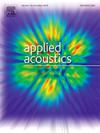Enhancing underwater single snapshot DOA estimation for limited dataset with modified knowledge distillation
IF 3.4
2区 物理与天体物理
Q1 ACOUSTICS
引用次数: 0
Abstract
In recent years, the progress in DOA estimation using deep learning algorithms has attracted significant attention. However, their heavy reliance on extensive datasets poses a critical limitation, particularly in underwater settings where data collection is arduous. Furthermore, the lack of temporal correlation and statistical properties inherent in single-snapshot information lead to low accuracy in single-snapshot DOA estimation. To confront the above hurdles, this paper introduces an approach to improve the accuracy of underwater single snapshot DOA estimation with limited underwater datasets. By modifying the process structure and model characteristics of knowledge distillation (KD), we construct a new distillation structure that can bridge the gap between single snapshot data and multi-snapshot data sharing identical labels, achieving a breakthrough in compressing multi-snapshot data. This enhances the neural network's capacity to process both few-snapshot datasets and single-snapshot datasets. In addition, we designed novel input features to reduce the difficulty of CNN fitting by extracting the real and imaginary parts of the analytical signals, and integrated the array structure information to improve the generalization ability of our network in different scenarios. Besides, based on these innovations, we build a mapping framework between synthetic and real underwater datasets. This work involves second-order joint training of KD and transfer learning, which can help deal with small samples. The experiment results of our method show significant improvements in underwater DOA estimation accuracy, coupled with a marked reduction in overfitting risks associated with limited datasets. This work not only advances the application of deep learning in challenging underwater scenarios but also lays a foundation for future data-driven inference strategies.
求助全文
约1分钟内获得全文
求助全文
来源期刊

Applied Acoustics
物理-声学
CiteScore
7.40
自引率
11.80%
发文量
618
审稿时长
7.5 months
期刊介绍:
Since its launch in 1968, Applied Acoustics has been publishing high quality research papers providing state-of-the-art coverage of research findings for engineers and scientists involved in applications of acoustics in the widest sense.
Applied Acoustics looks not only at recent developments in the understanding of acoustics but also at ways of exploiting that understanding. The Journal aims to encourage the exchange of practical experience through publication and in so doing creates a fund of technological information that can be used for solving related problems. The presentation of information in graphical or tabular form is especially encouraged. If a report of a mathematical development is a necessary part of a paper it is important to ensure that it is there only as an integral part of a practical solution to a problem and is supported by data. Applied Acoustics encourages the exchange of practical experience in the following ways: • Complete Papers • Short Technical Notes • Review Articles; and thereby provides a wealth of technological information that can be used to solve related problems.
Manuscripts that address all fields of applications of acoustics ranging from medicine and NDT to the environment and buildings are welcome.
 求助内容:
求助内容: 应助结果提醒方式:
应助结果提醒方式:


